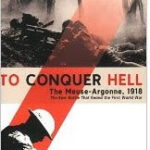Manila, Philippines is one of the few major Asian cities with an overt gay scene that openly contradicts the conservative culture of the country. Despite a homophobic environment that is critical and hostile to queer citizens a lively LGBT community thrives, and it vigorously leans into the face of the political, religious and legal establishment. This energetic and defiant movement manifests itself with political lobbying, social networking, street parades, sexually spicy venues–and a world LGBT conference.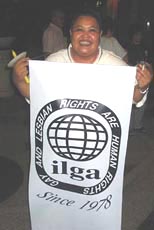
Also see:
Gay Philippines Stories
Gay Philippines News & Reports 2001 to present
Gay Philippines Photo Galleries
By Richard Ammon
Updated July 2008
The 22nd ILGA (International Lesbian and Gay Association) Conference in Manila
One of the best displays of Manila’s ‘gay power’ was the Manila conference of the International Lesbian and Gay Association that drew hundreds of delegates from 40 countries. It was significant in that this was the first time ILGA has held a conference in the anti-gay southeast Asian sub-continent. From China to Fiji to Indonesia to India, homosexuality is mostly condemned as a sin, a moral disorder, a legal offense or karmic enigma—all against the traditional heterosexual family order of things.
During the conference—which served as a nexus for planning political strategies, social networking and personal strengthening— stories of anguish and persecution, defiance and courage emerged as delegates from such disparate countries as Serbia, Nepal, Fiji and Zimbabwe shared tales of persecution and progress. [For more detailed accounts of these particular countries please access them through the home page of this site: http://www.globalgayz.com/ In addition to this story on gay Manila, updates will be posted very soon for Zimbabwe, Nepal, Serbia, Sri Lanka, India, Latvia, Guam, Croatia and Fiji.]
Philippine LGBT Organizations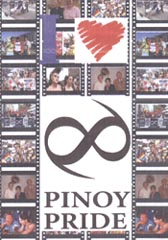
Organizing and managing the complex ILGA conference was no small task. Pulling together the necessary resources demanded close coordination and cooperation of nearly all Philippine LGBT groups and organizations. This show of integrated gay power was evident in the collective presence called Pinoy Pride.
Pinoy Pride
Pinoy Pride coalition is a network umbrella organization comprised of several Philippine sexual minority organizations: Can’t Live in the Closet-lesbian activist group (Makati-Manila); IWAG-gay social support group in Davao City, Mindanao; ProGay-gay rights organization (Quezon City-Manila); GAHUM-gay support and advocacy (Cebu City); Order of St. Aelred-spiritual gay center (Quezon City-Manila).
Other Pinoy Pride affiliate groups include KALAKASAN, LUNDUYAN, PIILIPINA, AIDS Society of the Philippines,, DKT Philippines, Reach Out Foundation International,SALIGAN, Positive Action Foundation Philippines, INC., PLUS, Tisha Gonzales, Kessler Go and JP De la Vega.
In addition to these LGBT groups, Pinoy Pride also includes affiliation with individual and representatives of private companies, non-governmental organizations, as well as governmental organizations, including the Dept of Tourism. Also joining with Pinoy Pride was ‘Womedia’—Women’s Media Circle Foundation (“empowering women through media advocacy”) which was responsible for the enormous secretariat work for the ILGA world conference in November 2003.
One of the more unique organizations is a LGBT ministry, the Order of St. Aelred, based in Quezon City (a suburb of Manila). Founded by Fr. Richard Mickley (photo right) in 1995, it ministers almost entirely to the LGBT community with support groups, religious teaching and church se rvices including gay weddings. Indeed, Fr. Richard—an ordained priest–was once threatened with deportation to his native Philadelphia for conducting gay matrimonies, but that threat has now passed. More about St. Aelred can be seen at their website.
rvices including gay weddings. Indeed, Fr. Richard—an ordained priest–was once threatened with deportation to his native Philadelphia for conducting gay matrimonies, but that threat has now passed. More about St. Aelred can be seen at their website.
This wordy listing of Pinoy Pride’s component groups is intended to give offer awareness of the many activist organizations currently operating in the Philippines on behalf of LGBT rights and recognition. This is no meager third world LGBT effort. The other reason for the listing is to reveal the present and ever-changing progress of the Philippine LGBT community. Pinoy Pride is a new central unity that has been coalescing for several years to become a nationally identifiable organization. It’s first major undertaking was also it’s first major success; the ILGA conference was well organized, comprehensive and inclusive. A complete summary of the conference can be found on the ILGA website.
Pride March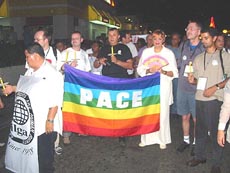
On the final night of the conference, Pinoy Pride sponsored a Pride March. Despite the conservative establishment, we had police escort along the highly-trafficked road. What wonderful organized chaos it was—“Philippine style” said one local. (The common expression is ’bahalana’—come what may). Indeed it was an assemblage that fell into place as we went along.
About 200 attendees from the conference marched out of the host Century Park Hotel into the dense traffic with our banners (that could hardly be read because it was night time) and candles (that blew out in the wind) and shouts and chants (muffled by the traffic noise). Nevertheless, with undaunted enthusiasm we moved ahead.
Part way along the route a huge rainbow flag appeared carried by a dozen bouncy young Filipina lesbians. Further on a couple of truck-floats joined in. One of them carried a bevy of drag queens as well as muscle boys dressed as angels.
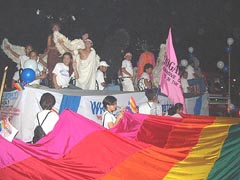
We were a scrambled and joyfully loose assembly of human rights marchers with onlookers gawking and staring. It was serious and silly and all in the spirit of celebration. Just as we reached our destination park it started to rain so we all piled into jeepney taxi buses and headed off to our appointed restaurant for a banquet, laughter and music.
[Note: Every June Pride Manila stages an annual and much grander parade.]
Pro Gay Organization
Major support for the conference also came from the Pro-Gay Philippines organization.
From their web site (http://members.tripod.com/~progay_philippines/) are these words:
“ In September 1993, Pro-Gay Philippines was born when several progressive gay student activists gathered as a study group that tried to develop a concept of gay Filipinos’ roles in the movement for national and social liberation. Pro-Gay-Philippines believes that gay liberation involves not just gay men but also all other people of different sexual orientations.
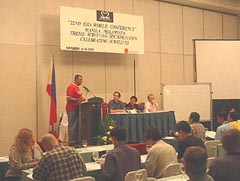 “ Like other oppressed and exploited people, we struggle for social equality. We define the struggle for gay liberation as a part of the struggle of the Filipino people for national freedom, and at the same time, this has a distinct concern for the concrete demands of Filipino gay men.
“ Like other oppressed and exploited people, we struggle for social equality. We define the struggle for gay liberation as a part of the struggle of the Filipino people for national freedom, and at the same time, this has a distinct concern for the concrete demands of Filipino gay men.
“ Pro-Gay advocates for the full recognition of economic, social and political rights of all sexual minorities to freedom from all forms of sexual discrimination in family, the community, the government, church and mass media. We advocate respect, acceptance and support from our families and a stop to the false representation of gays in the church, mass media and academia.”
Personal Talks about Gay Philippines
Aside from the ILGA conference I had conversations with native LGBT Filipinos and Filipinas. In one such talk I was informed that there are a variety of gay lifestyles in Manila and other urban centers in the Philippines.
I met a thirty-something Filipino, Bengi, for lunch one afternoon A university graduate now working as a consultant in the computer industry, he had a quick mind and also a clear sense of his sexuality. “My friends sometimes make fun of me; they say I must be a lesbian because I want a gay boyfriend. They don’t understand the kind of gay life I want. I am a man and I want a man boyfriend to live with. I’m not a flaming kind of guy.” His model of a relationship is one of several he described.

(2) Subdued gay types, closeted Pa-‘mhin’ (corruption of the word man) or ‘man-wannabees’. Said Bengi, “The parlor gays just trash them. These are the obvious types (butch softy’s) whom the pa-gays just abhor because of their duplicity. They dress like ordinary or men and deny their sexuality for fear of ostracism. Many get married to hide their truth and sneak out for gay sex. “Rarely is a pa-mhin available as a steady boyfriend, which makes the pa-girls frustrated and scornful.
(3) Bengi’s own model is a third kind: “urban gays–regular looking guys with preference for lovers like themselves. Usually educated and not ashamed to be gay, they prefer to be ‘straight-looking’ for the simple reason that “we would probably look ridiculous as women” laughed Bengi. But more seriously, he explained, “I’m just a regular guy who happens to be gay I don’t dress up or show it.” This lifestyle is closer to the typical western ‘guppie’ (gay yuppie) model: has a nine-to-five career, and is in a monogamous, live-in, equal-role man-to-man (woman-to-woman) emotional bond with a partner.
Gay-Straights and the Church
Throughout Manila are magnificent ancient and new churches, some dating back to the 16th century. Many of the churches are used to meet pragmatic needs—they run schools, which are often next door to the churches. From an early age it’s difficult to escape being a Catholic in this country, as many LGBT folks attest. And equally hard is throwing off the mantle of guilt that comes with the catechism.
 It’s hard to feel proud of being gay against such strong religious disapproval. So it’s little wonder that many gay people follow tradition down the church aisle to sham hetero marriages. Later, after the celebrations and feasts are over, many of these people find their way to a new or previous discreet ‘affair-of-the-heart’ with a same-sex partner.
It’s hard to feel proud of being gay against such strong religious disapproval. So it’s little wonder that many gay people follow tradition down the church aisle to sham hetero marriages. Later, after the celebrations and feasts are over, many of these people find their way to a new or previous discreet ‘affair-of-the-heart’ with a same-sex partner.
And as well, a closer look at the private life of ‘straight’ spouses and singles, according to Bengi and others, will often reveal flirtations and indulgence in homosex for pleasure, whim or oblique affection.
As mentioned before, some are in an arrangement with a fem guy (’pa-girl’) who pays a mostly-straight guy to be his secret boyfriend. I inquired how a straight man would willingly give himself to a gay person even if only for a while. Bengi laughed and said, “Yes, these boys go to church and pretend to have girls friends–but they like money and sex even more, I think!”
Such pa-girl-straight-boy arrangements are commonly a matter of sex and money and these may be the only bonds that keep them together. The ‘pa-girl’ is sometimes the sole support for the boyfriend who may or may not stay long and may or may not temporarily give up girls.
These arrangements vary according to each couple but loyalty is always a risky challenge for them.
Bengi reminded me: “a relationship, whether long term or short term, with a straight man will not guarantee equality since it will always be rooted in something material, sexual or financial. Social, sexual, religious and orientation issues constantly push against the success of these often one-sided love affairs.
Still, some do fare well: “I know some friends who have been together for five years now”, Bengi claimed. “They’re very happy. They like each other a lot. She makes a happy life for him and he is nice to her. He brings her flowers and they go dancing at the disco!” After five years, I thought, is anyone wondering if this is a gay-straight relationship? As is often the case in Asia, sexuality is more mercurial than in the West.
During his college years in Manila, Bengi came out and was exposed to the wide variety of gay love styles that exist there; “I went to the bars and discos and saw the drag queens but didn’t want to do that. I had other friends who stayed home with their boyfriends or went out to dinner–like ‘normal’ people. I guess I’m more normal than gay. I definitely prefer another gay person who is similar to me.”
Lesbian Life in the Philippines
Lesbians are particularly active in the Philippines–more so than in any other Asian country (aside from NZ and Australia.) The following commentary about Filipinas comes from the Gay.com web site and was authored by Malu Marin. http://content.gay.com/channels/arts/inthelife/905philippines.html Her words captures well the important and activist role of lesbians in the Philippines.
“ In the last five years, the lesbian movement in the Philippines has been actively engaged in fighting sexism and discrimination against lesbians. As with other movements that endeavor to change consciousness, the rewards of this collective activism can be reaped over time.
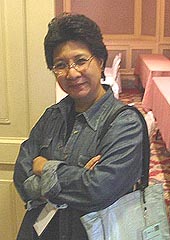 Anna Leah Sarabia Anna Leah Sarabia |
“ It cannot be denied that some inroads have been made. For instance, CLIC (a group called Can’t Live in the Closet) has been able to arrange dialogues and discussions with some sectors within the Catholic Church. Many of those who attended the dialogues (Catholic nuns, seminarians, theology teachers, lay missionaries) attest to the importance of holding such sessions in order to facilitate a more enlightened and progressive view of lesbian issues and concerns.”
[Can’t Live in The Closet, Inc. (CLIC) is headed by its director, Anna Leah Sarabia who is also the current Co-chairperson of ILGA and the chief organizer for the ILGA conference in November 2003. CLIC was conceived in October 1993 as a lesbian institution working for the empowerment of lesbians and societal recognition of their human rights. To achieve this, CLIC has adopted a two-pronged approach: first, it provides education, information, psychological and emotional support, safe spaces and venues for self-expression to lesbians; and second, it provides education and information to mainstream society in order to facilitate recognition and understanding of lesbian issues.]
Malu Marin continues: “ Lesbians and gays also have begun a more conscious and programmatic approach to legislative advocacy. This recent effort resulted in the filing of a proposed law (House Bill 7165) recognizing the rights of lesbian and gays, an imperfect but significant legislative proposal. One very important but relatively unknown development is the inclusion of positive and nonjudgmental mention of homosexuality and bisexuality in the Core Messages of the Population Education Program of the Department of Education, Culture and Sports.
[The author of the proposed law, the Hon. Bellaflor Angara-Castillo, Representative from Aurora Province–gave a keynote speech at the ILGA conference opening ceremony.]
“ In the media, the presence of “Lezz Talk” (formerly “Rainbow Rap”), a four-year-old twice a month lesbian column in a mainstream magazine, has done a lot to provide unbiased information to lesbians and non-lesbians. Yet, while there has been increased visibility for lesbian issues in the media, the treatment of the subject leaves much to be desired. In literature, the launching of Tibok, Heartbeat of the Filipino Lesbian, a collection of personal essays, poetry and other writings, shows the progress of lesbians. Filipino gay men, on the other hand, already have a number of literary publications, such as Kabaklaan magazine.” (End of Gay.com commentary.)
Manila’s LGBT Night Scene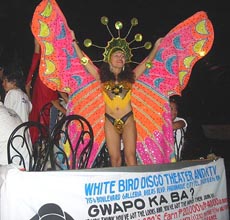
Gay Manila was a pleasant and startling surprise to me. To the (mostly helpless) horror of the dominant Catholic establishment, Manila sports numerous trendy gay bars, flashy discos and explicit clubs that strut their stuff with mountainous sound systems, light storms, go-go dancers and sex shows.
Saturday night of the ILGA conference was our night for the gay bars so I went to 2 places. The first was a very stylish, crowded and loud bar-dance club called ‘Bed’. This is a dazzle that exudes a sensual party atmosphere with stylish interiors. A mezzanine and open staircase provide good views for people watching. DJs spin “new and banging progressive house and trance music from around the world”. There’s a friendly and handsome staff plus a large aquarium tucked away in an all too familiar spot. The weekly and week-end crowd is mostly hip, party minded local gay professionals and expats/tourists.
(Quote from http://dragoncastle.net/philippines.html )
Bed is located in the Malate district of Manila which has become the ‘in’ place for countless gay and straight nightlife bars and clubs and restaurants, especially on the weekends. Traffic comes to a virtual standstill in the area. “It is at once exciting and exhilarating, flamboyant and vivacious, diverse and accepting,” claims one magazine.
Some of the mixed and LGBT listings here are: Komiks boutique restaurant (“enigmatic’); Pride Exchange sex shop (“naughty’); Fidel bar and restaurant (“chic”); Acquario bar (“blue ambience’); Mamma bar and restaurant (“calm and subdued”); People’s Palace restaurant (“soft’); Sala bar and restaurant (“well-groomed waiters”); and Firm boutique shop (“bold”), among many others.
The second event of our exploration of Manila’s gay night life was a stripper bar, White Bird, with non-gay so-so looking guys gyrating their naked and semi-naked tits and asses. During a few of the ‘dance’ routines the guys wore strap-on erections. Most of the audience were straight young women who shrieked with nervous embarrassment as the ‘aroused’ strippers came over to touch them. The minority of gay guys in the audience were nevertheless amused and some thrilled. I found the music loud and the show routines repetitious. (Straight strippers don’t come close in comparison to gay strippers, if you ask me.) The next day some of our group hotly debated whether the strap-ons were real or not! (I voted for the fakes.) A native Manila queer overheard us and told us that White Bird was not the hottest place; there are others where live (real gay) sex is performed on stage. I didn’t find out what or where. Check out DragonCastle’s site.
During a couple of casual social hours in the conference, reps from some of the other gay and bi venues handed out invitations and discount tickets: Sunmills Reloaded (bar)
In Quezon City and Fahrenheit (bath house) also in Quezon City.
Lunch with Joel
I had another conversation about gay Philippines with twenty-something Joel during the conference lunch break. Joel was part of the coordinating committee charged with keeping the ILGA conference running smoothly. (Delegates never seemed to start their seminars and workshops on time as they had so much ‘sharing’ to do.) Joel had a boyish face, a thick shock of black silky hair and soft, playfully cruisy dark eyes. He was always ready with a light laugh yet thoughtful approach to the delegates’ many needs and requests—and to my questions.
I asked Joel what accounts for the reasonable level of tolerance in Manila for LGBT people?
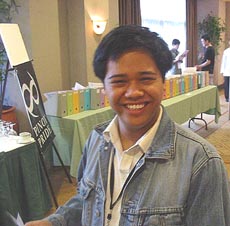 Joel Joel |
Joel: In the Philippines, a tradition of tolerance toward ‘different’ people has emerged over the past century despite the tight grip of Catholicism that came with the Spanish invasion in the 16th century. It’s possible that the tolerance comes from being subjugated by the church, by foreigners –and Marcos–for so long and now more recently we are rebellious against all that oppression.
[The Americans occupied Philippines after 1898, until 1942 when the Japanese crashed onto the land for three brutal years until the Americans took over again. This prepared the way for the corrupt dictatorship of Marcos from 1965-86. The eruption of Mt Pinatubo in 1991 sent most of the US armed forces home finally leaving the Filipinos to wholly govern themselves.]
The church is different here than in Rome. You know for a long time, in the past, Filipino priests had families. The thinking and rituals were not as rigid. Sin is something that is easily forgiven and being gay is not the same horror as other places. Priests are not so freaked out at gays or cross-dressers.
Besides, Joel continued, even in the Philippines we have so many different cultures inside our country that we have to accept one another. There is also this idea that you mind your own business and if someone is different we look the other way and leave them alone if we’re not interested. We have a saying—‘bahalana’—that means ‘come what may’ or ‘things will happen’ or ‘it’s a mystery’.
This mind-set can work both ways, good tolerance of gays and bad tolerance for harassment of women, domestic violence, air pollution or police pay-offs. There is much corruption—by mafia, priests and politicians–at the local and state levels that is not addressed. It’s known that some brothels are owned by policemen. So gay is just another culture, another different action that is often side-stepped.
Also, we are a democracy with a constitution that allows a lot of freedoms. We know that the government is not out hunting down the queers so we have our Pride Parades and our activists.
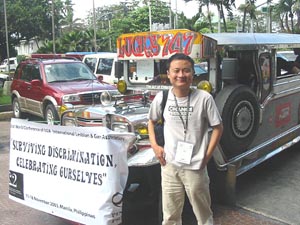 Another possible reason for tolerance is that ours is a matriarchal society so a son who is not typically macho is more acceptable. A gay child—man or woman—is sometimes seen as another parent in the family. They will not go off and find a spouse and start a family so there is a continued dedication—and financial support–to the parents and siblings. When I came out to my family they were more worried about my happiness than they were upset or angry.
Another possible reason for tolerance is that ours is a matriarchal society so a son who is not typically macho is more acceptable. A gay child—man or woman—is sometimes seen as another parent in the family. They will not go off and find a spouse and start a family so there is a continued dedication—and financial support–to the parents and siblings. When I came out to my family they were more worried about my happiness than they were upset or angry.
Further, a gay businessman—if it is known—is also sometimes respected because he tends to be more dedicated to his work and not distracted by his wife and children.
Q: But Filipinos and Filipinas don’t go about broadcasting they are gay because discrimination in the public sector is still very real.
Joel: Yes, this is true. So most gay men give in to a church wedding because of the pressure from their families. More so in the rural areas than in the big cities. It’s a family honor thing. This is the ‘pa-mhin ‘ kind of guy. Making babies—with a virgin bride—is the traditional thing to do.
But you know, a lot of gay action here is a kind of ‘bachelor phase’ for young guys before they get married. I went to boarding school and that was a breeding ground, so to speak! It’s a fun release for the straight guys and a playground for the gay guys, even though we weren’t out yet. Some of straight the guys had girlfriends at school and still wanted to fool around with the guys. I heard some of them say that having a ‘boyfriend’ was less complicated than a girlfriend, less manipulative. But these are really dead end romances for gays. What’s great is that in the ‘90s a few queer schoolboys got a lot bolder and started openly dating other guys. So that’s really out there.
Q: Transvestites are a big hit in the Philippines. They have pageants and beauty contests. They are public performers. Why are they so popular?
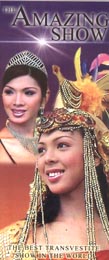
Joel: Yes, and many of them are out, loud and gay. They are not afraid of society and not afraid of men. They know women have this sexual matriarchal power from the culture and in drag they flaunt it at other men to entice and tease them in a dominating way. The straight women love it because the trannies do it better than they do. A lot of straight men go to the shows and some are turned on, It’s not unusual that a hookup is sometimes arranged after a performance.
The Amazing Show
As if to further answer my question, the following night after talking with Joel, the conference delegates were invited to attend a transvestite show called ‘The Amazing Philippine Theatre’ which presented dozens of trannies in outrageous and flamboyant floral and feathered costumes in song and dance routines. The venue for this show was no small out-of-the-way stage. Rather it was performed at the national Cultural Center in downtown Manila. Surprisingly—or perhaps not– this extravaganza was not just for the benefit of the conferees. Their brochure said there were daily shows at 7:30 and 9:30 PM.
Obviously it’s a popular show in this culturally-mixed, tolerant, passionate, Catholic, sexually fluid and politically wired-up and wondrous country of 7000 islands.
Bahalana—it’s a mystery.


